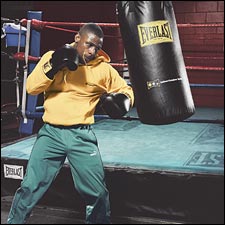MAIN EVENT
boxing
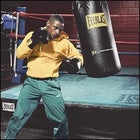 SWEAT SET: Cotton-and-polyester hoodie () by Champion; polyester track pants () by Puma; leather-and-nylon-mesh boxing shoes () by Everlast
SWEAT SET: Cotton-and-polyester hoodie () by Champion; polyester track pants () by Puma; leather-and-nylon-mesh boxing shoes () by EverlastA body built to box is a body built to last.
As we know from Million Dollar Baby and The Contender, Sly Stallone’s reality-TV show, boxers are in phenomenal shape. How could they not be? The workouts engineered to build great fighters with the stamina to go 12 rounds make for a powerful one-two punch, resulting in one of the most comprehensive cross-training plans around. The good news for you is that it’s possible to benefit from this training style without ever getting in the way of a flying fist.
According to Brach Poston, a former University of Nevada at Las Vegas strength coach who’s now a doctoral candidate in integrative physiology at the University of Colorado, training for the ring delivers a bevy of performance boosters that carry over to other sports. A well-conditioned boxer enjoys heightened hand-eye coordination, ideal for throwing and swinging sports like baseball and golf; lightning-quick reflexes, necessary for hoops, mountain biking, and skiing; improved core strength, great for paddling; and better foot speed, for racket sports such as tennis and racquetball. Moreover, your newfound defensive skills will boost your self-confidence—which will in turn give you an added edge in pretty much any athletic endeavor you pursue.
Around the country, more and more athletes are turning to boxing to give them a performance advantage. Oscar-winning actor Cuba Gooding Jr. swears that regular pugilistic workouts have improved his speed and agility in his other athletic passion, ice hockey. University of Southern California football star Winston Justice credits his four-days-a-week off-season boxing sessions with turning him into a favorite to win the 2005 Outland Trophy, awarded to the nation’s best collegiate lineman.
Adding to the sport’s appeal is its low-maintenance practicality. You don’t have to step into the ring to begin your training; your garage or back porch will do just fine. Plus the equipment is beautifully uncomplicated (our picks begin below), and the twice-a-week workout outlined on page 50 takes less than an hour. That leaves you plenty of time to apply your freshly honed agility and fleetness to any adventurous pursuit.
ESSENTIAL GEAR
Everlast Indoor-Outdoor Heavy Bag
($100; )
“If I could have only one piece of workout equipment for the rest of my life, it would be a heavy bag,” says Dave Gaudette, 55, owner of the Front Range Boxing Academy, in Boulder, Colorado. “It works every muscle from your ankles to your neck.” The 70-pound Everlast model is packed full of recycled-rubber scraps for even density, while its vinyl skin makes it suitable for either indoor or outdoor installations. Lay into it out on your back patio.
Everlast High Performance Super Bag Gloves
($35; )
Boxing gloves fall into three main categories, and the difference boils down to ounces. Bag gloves like the Everlasts are generally four to 12 ounces each. Fighting gloves are a little beefier—they usually run eight or ten ounces. Meanwhile, training gloves, at ten to 20 ounces, are typically heavier still, to build hand speed. All three varieties are padded with impact-resistant foam rubber.
Four for Fighting
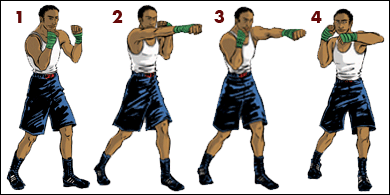
Before you strap on gloves, you’ll need to learn the basic boxing stance, the foundation that puts muscle behind every move. Once properly planted, you can start throwing the sport’s three basic punches: the overhand, the jab, and the hook.
1.) Basic Stance
Stand almost sideways, relative to your target, with your left foot forward, right foot back, legs slightly more than shoulder width apart, and weight evenly distributed on the balls of your feet. Keep your fists up, in front of your chin, elbows tucked in. This forces you to use your hips, the power source for a well-thrown punch.
2.) Overhand
For the overhand right, start with your right fist almost touching your chin, elbow tucked into the ribs. As you explode the arm straight out, rotate your right hip forward until that leg straightens out, with the ball of your right foot on the floor. Throw the punch and return to stance in one move.
3.) Jab
To throw a smooth jab, fire your left fist out in a straight line, twisting your arm inward until you reach full extension. Then immediately snap your fist back to your chin.
4.) Left Hook
For the left hook, swing your elbow up so that your forearm is parallel to the ground, then punch, using only your body. Twist your torso, from your legs to your shoulder, into the hook.
The Ten-Round Pound
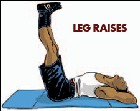
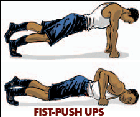

The Ten-Round Pound
After you learn the basics (see ““), step up to our 40-minute routine from Steve Petramale, owner and trainer at Shadowboxing Gym, in Hollywood. This workout follows the traditional training format of three minutes of exercise followed by one minute of rest per round. For the last 30 seconds of each round, jack up your intensity. During the one-minute break between rounds, sip some fluids, walk around, and let your heart rate drop. But don’t sitreal boxers always keep moving when they’re training.
ROUND 1: Jump Rope
It’s difficult to jump with a rope mistake-free for 60 seconds, much less three minutes, so take a break with side swings: Spin the rope at either side of your body while you keep jumping in place.
ROUND 2: Shadow Boxing
Use a mirror to examine your stance, hand position, and punching mechanics. Start shadow boxing by assuming the basic stance, then move forward, back, and side to side in small, quick steps. Next, incorporate a couple of jabs with each step, throwing a left as you step in with your left leg. Go slow to make sure you’ve got your form dialed, then try throwing overhand punches, taking care to turn your hips into the blow. After 90 seconds, begin to throw punches at an imaginary opponent. Throw two or three jabs and combos, back off, then repeat. Concentrate on form, not speed or power.
ROUND 3: Heavy Bag
Stand an arm’s length away from a bag and start popping it with the right hand after throwing a few jabs. “A quality punch does not cause the heavy bag to sway all over the place,” says Petramale. “You should feel a solid thud and see the bag shudder.” Land some combos, then take a few small steps clockwise, gliding around the bag.
ROUND 4: Heavy Bag
Pick up the pace and step closer, landing combos like the double jab, triple jab, one-two (a left jab followed by a right punch), and one-two-three (left jab, right punch, left hook).
ROUND 5: Heavy Bag
The goal of this round is “tempo” punching. Keep your knees bent and butt down, hands up high, body square with the bag. Pivot with your shoulders and torsonot your armsto throw a punch. Alternating hands, tap the bag lightly in the same spot (around chin height), without varying the punches, until a rhythm develops. The lighter and faster you punch, the more you’ll get out of the drill. Every 30 seconds, increase the intensity of your punches for five seconds.
ROUND 6: Heavy Bag
By this point in the program you’re loose, mechanically primed, and ready to put speed and power together for the most intense three minutes of the workout. Start with a left jab and a right overhand. Stick the combo and then move. Step closer to land another combo, then spring back outside of your imaginary opponent’s reach. Concentrate on hand speed more than power. Finish it off by punching nonstop for the last 30 seconds.
ROUND 7: Jump Rope
Repeat Round 1.
ROUND 8: Shadow Boxing
Cool down by throwing short, easy jabs and punches while staying light on your feet and moving around.
ROUND 9: Speed Bag
Hitting a speed bag correctly takes time and practice but pays off in sharper timing and reflexes. Stand square with the bag, about 18 inches away. Hold your fists up by your ears, elbows out, and strike the bag with short, slow circular motions, keeping the ball side of your fist forward. Hit the bag three times with one fist and three with the other, maintaining a consistent rhythm as you alternate sides.
ROUND 10: Core Strength
Do the following exercises in quick succession, finishing within three minutes. Complete ten reps of each to start; work your way up to 20.
1//Leg Raises
Lie on your back, left hand behind your head, right hand on your waist. Keeping your legs straight, lift your feet over your head until your soles are facing the ceiling. Lower your legs slowly back to the ground while you push the back of your head into the floor to complete one rep. Alternate hand positions with each rep.
2//Fist Push-Ups
Lie facedown and cross your legs, then push yourself up on your fists and one foot, keeping your torso straight. Lower yourself and touch your left cheek to the floor. On the next rep, touch your other cheek. Do as many as you can.
3//Modified Bicycles
Lie on your back, with your hands laced behind your head, elbows out, and legs straight. Lift your shoulders off the floor while bringing your left knee toward your chest. As your torso rises, twist your shoulders so that your right elbow almost touches your left knee. Alternate elbow and knee with each rep.
4//Fist Push-Ups
Adjust hand width (closer in or farther out) and switch feet position from last set.
5//V-Ups
Lie on your back with your legs perpendicular to the floor and spread wide. With your hands pressed together as in prayer and on your chest, extend your arms toward your left foot, while lifting your shoulders off the ground. Lower yourself back down and then reach for your right foot to complete one rep.
Essential Gear, PT I
boxing
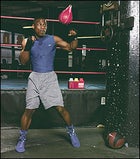 BLUE STREAK: Polyester-and-spandex singlet ($25) by Nike; polyester shorts ($20) by Russell Athletic; leather-and-nylon-mesh boxing shoes ($80) by Everlast
BLUE STREAK: Polyester-and-spandex singlet ($25) by Nike; polyester shorts ($20) by Russell Athletic; leather-and-nylon-mesh boxing shoes ($80) by EverlastTitle Mexican Style Handwraps
($5; )
Cotton hand wraps will protect your tendons and bones as you unload the day’s frustrations on the bag. Of the two varieties—traditional and Mexican style, which are thinner and slightly elastic—trainers who prefer the latter argue that they more closely conform to the hands. Either way, look for at least 180 inches of length and a Velcro closure to secure the loose end.
Ringside Spar-Mate Timer
($150; )
The workout on page 50 is designed around the three-minute interval, which represents a round in the ring. The Spar-Mate timer pictured here punctuates sessions—plus 30-second or one-minute rest periods—with buzzers and lights. It’s a vital tool, because you won’t want to take your eyes off the bag to consult a wall clock. Skeptical? Try fussing with an egg timer when you’re wearing gloves.
Cleto Reyes Speed Striking Bag
($70; )
The speed bag builds killer hand-eye coordination, but it’s also one of the more challenging exercises in the gym. Expect to invest months before you get that Hilary Swank rhythm going. Start out slow (as in one thump per second) with a seven-by-ten-inch medium-size bag like the Cleto Reyes shown here, inflated to about 90 percent of capacity.
Nike Eight-Pound Strength Training Ball
($35; )
Nubby rubber has edged out leather as the material of choice for that classic torture-training tool, the medicine ball. The rough surface texture helps improve your sweaty grip on these beasts, which range in weight from four to 20 pounds. Rubber wears faster than leather, but unlike hide, the bouncy stuff will retain its shape longer.
Essential Gear, PT II
boxing
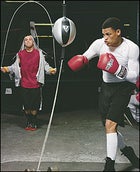 SPARRING STYLE: Right, polyester-and-spandex crew ($48) by Nike; polyester-and-spandex shorts ($30) by Banana Republic; leather-and-nylon-mesh boxing shoes ($80) by Everlast; left, polyester-and-cotton hoodie ($62) by Puma; polyester-and-spandex T-shirt ($25) by Nike; cotton-and-polyester shorts ($34) by Puma; boxing shoes ($150) by Adidas
SPARRING STYLE: Right, polyester-and-spandex crew ($48) by Nike; polyester-and-spandex shorts ($30) by Banana Republic; leather-and-nylon-mesh boxing shoes ($80) by Everlast; left, polyester-and-cotton hoodie ($62) by Puma; polyester-and-spandex T-shirt ($25) by Nike; cotton-and-polyester shorts ($34) by Puma; boxing shoes ($150) by AdidasTitle Platinum Double End Bag
($40; )
The double-end bag is the closest you’ll come to the ducking and jiving of actual in-the-ring sparring: This one fights back. Suspend the eight-inch leather sphere between floor and ceiling on cords, as pictured above. Once hit, it’ll reel back like an opponent’s head, then swing forward in a wicked counterpunch. “Hit the double-end bag and get out of the way,” says Bruce Silverglade, owner of Gleason’s Gym, in Brooklyn. “Otherwise it’s gonna come back and pop you in the nose.”
Ringside Original Super Bag Gloves
($50; )
“Good gloves evenly distribute the padding,” says Dave Gaudette, of the Front Range Boxing Academy, in Boulder. Any weight up to 16 ounces will work, but beginners should go with six-ouncers to avoid needlessly exhausting themselves. Tip: Strong leather is durable, but stitching accuracy can vary. Whichever brand you choose, inspect before you buy.
Essential Gear, PT III
boxing
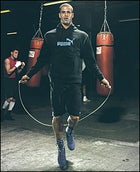 JUMP SUIT: Cotton-and-polyester hoodie ($45) and shorts ($34) by Puma; leather-and-nylon-mesh boxing shoes ($80) by Everlast. Photographed at Gleason’s Gym, Brooklyn, New York
JUMP SUIT: Cotton-and-polyester hoodie ($45) and shorts ($34) by Puma; leather-and-nylon-mesh boxing shoes ($80) by Everlast. Photographed at Gleason’s Gym, Brooklyn, New YorkTitle Super Boa Speed Rope
($15; )
Heavy rubber ropes weigh up to four pounds and work the shoulders, arms, and core, while lightweight speed ropes like this Super Boa hone agility. Durable leather versions fall somewhere in between. Whichever you choose, look for foam-rubber grips and high-quality ball bearings. To find the right length, stand with one foot in the middle of the rope. The handles should hit your armpits.
WHERE TO FIND IT:
ADIDAS, ; BANANA REPUBLIC, ; CHAMPION, ; EVERLAST, ; NIKE, ; PUMA, ; RUSSELL ATHLETIC,



